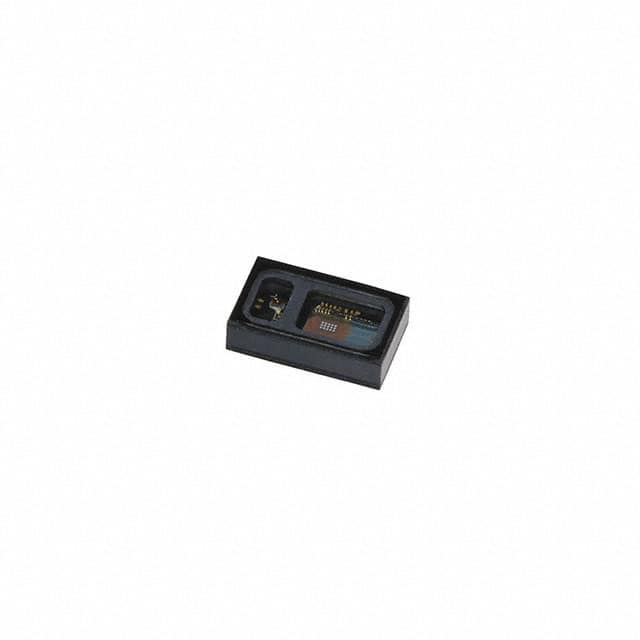Xem thông số kỹ thuật để biết chi tiết sản phẩm.

MAX30102EFD+T
Product Overview
- Category: Integrated Circuit (IC)
- Use: The MAX30102EFD+T is a highly integrated optical sensor module for heart rate and blood oxygen saturation (SpO2) monitoring applications.
- Characteristics: This sensor module integrates red and infrared LEDs, a photodetector, optimized optics, and low-noise analog signal processing to detect pulse oximetry and heart-rate signals. It operates on a single 1.8V power supply and communicates through I2C interface.
- Package: The MAX30102EFD+T comes in a small, 14-pin optical module package.
- Essence: The essence of the MAX30102EFD+T lies in its ability to provide accurate heart rate and SpO2 measurements in a compact and easy-to-use package.
- Packaging/Quantity: The MAX30102EFD+T is typically available in tape and reel packaging with a quantity of 2500 units per reel.
Specifications
- Power Supply: 1.8V
- Interface: I2C
- Operating Temperature Range: -40°C to +85°C
- LED Wavelengths: Red: 660nm, Infrared: 880nm
- Sampling Rate: Adjustable from 50Hz to 3200Hz
- ADC Resolution: 18 bits
Detailed Pin Configuration
The MAX30102EFD+T features the following pin configuration: 1. VIN (Power Input) 2. SDA (I2C Data) 3. SCL (I2C Clock) 4. INT (Interrupt Output) 5. RD (Red LED Anode) 6. RGND (Red LED Cathode) 7. IRD (Infrared LED Anode) 8. IRGND (Infrared LED Cathode) 9. PD (Photodetector Anode) 10. PGND (Photodetector Cathode) 11. RSET (Resistor Set) 12. MODE (Mode Control) 13. TEMP (Temperature Output) 14. AGND (Analog Ground)
Functional Features
- Accurate heart rate and SpO2 monitoring
- Low power consumption
- Integrated red and infrared LEDs
- High-resolution ADC for precise signal acquisition
- Flexible sampling rate adjustment
- Interrupt output for event-driven applications
Advantages and Disadvantages
Advantages
- Compact and integrated design
- Low power consumption
- High accuracy and resolution
- Flexible sampling rate
- Suitable for portable and wearable devices
Disadvantages
- Limited to specific applications such as heart rate and SpO2 monitoring
- Requires careful optical and electrical design for optimal performance
Working Principles
The MAX30102EFD+T utilizes the principles of photoplethysmography (PPG) to measure changes in blood volume and oxygen saturation. It emits light from the red and infrared LEDs into the skin and measures the amount of light absorbed by the blood. By analyzing the variations in light absorption, it can accurately determine the heart rate and SpO2 levels.
Detailed Application Field Plans
The MAX30102EFD+T is widely used in various medical and fitness devices for monitoring heart rate and SpO2 levels. It is commonly employed in wearable fitness trackers, smartwatches, and medical monitoring equipment. Additionally, it finds applications in hospital patient monitoring systems and portable health devices.
Detailed and Complete Alternative Models
- MAX30101: Similar to MAX30102EFD+T but with different package options
- MAX30112: Offers additional features such as ambient light cancellation and advanced motion artifact rejection
- Si1143: Provides similar functionality with integrated UV index sensing capability
In conclusion, the MAX30102EFD+T is a versatile and reliable optical sensor module that caters to the growing demand for accurate heart rate and SpO2 monitoring in various applications.
Word Count: 615
Liệt kê 10 câu hỏi và câu trả lời thường gặp liên quan đến ứng dụng MAX30102EFD+T trong giải pháp kỹ thuật
Sure, here are 10 common questions and answers related to the application of MAX30102EFD+T in technical solutions:
Q: What is MAX30102EFD+T? A: MAX30102EFD+T is a highly integrated optical sensor module for heart rate and blood oxygen saturation (SpO2) monitoring applications.
Q: How does MAX30102EFD+T measure heart rate and SpO2? A: It uses a combination of red and infrared LEDs along with a photodetector to measure the absorption of light by the arterial blood.
Q: What is the operating voltage range for MAX30102EFD+T? A: The operating voltage range is typically 1.8V to 2.0V.
Q: Can MAX30102EFD+T be used in wearable devices? A: Yes, it is suitable for use in wearable fitness trackers, smartwatches, and other portable health monitoring devices.
Q: What is the sampling rate of MAX30102EFD+T? A: The sampling rate can be adjusted from 50Hz to 3200Hz.
Q: Is MAX30102EFD+T suitable for continuous monitoring of heart rate and SpO2? A: Yes, it is designed for continuous monitoring in real-time applications.
Q: Does MAX30102EFD+T have built-in motion artifact compensation? A: Yes, it includes advanced algorithms for motion artifact rejection, making it suitable for use in active environments.
Q: Can MAX30102EFD+T communicate with microcontrollers or other devices? A: Yes, it has an I2C interface for easy integration with microcontrollers and other digital systems.
Q: What is the typical power consumption of MAX30102EFD+T? A: The typical power consumption is low, making it suitable for battery-powered devices.
Q: Are there any specific design considerations when using MAX30102EFD+T in a medical device? A: Designers should consider factors such as ambient light rejection, temperature stability, and electromagnetic compatibility when integrating MAX30102EFD+T into medical devices.
I hope these questions and answers are helpful for your technical solutions! Let me know if you need further assistance.

